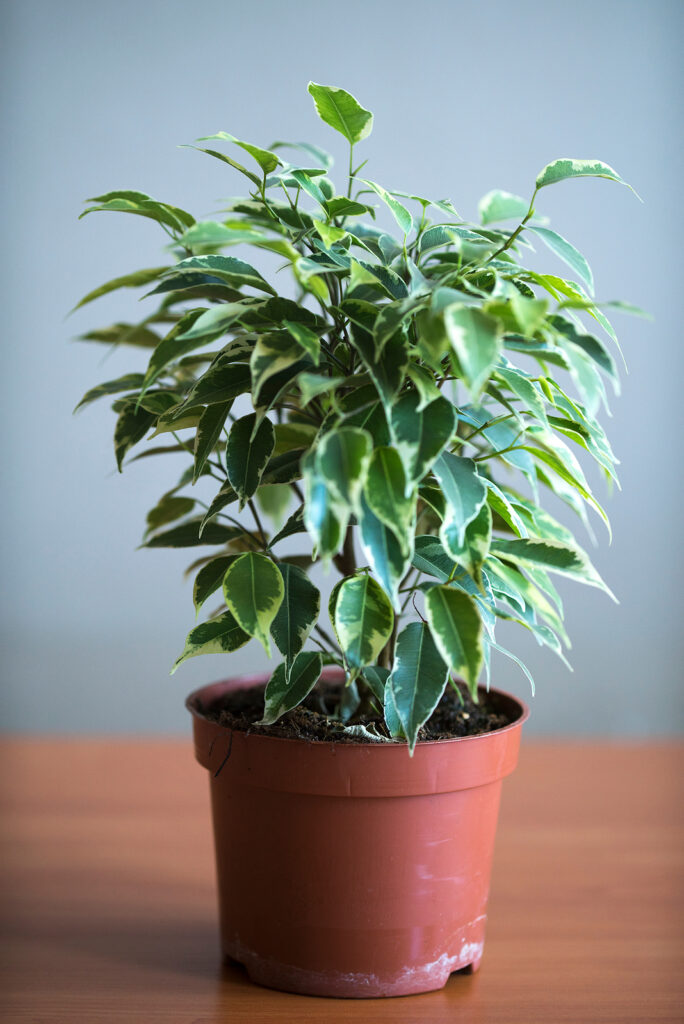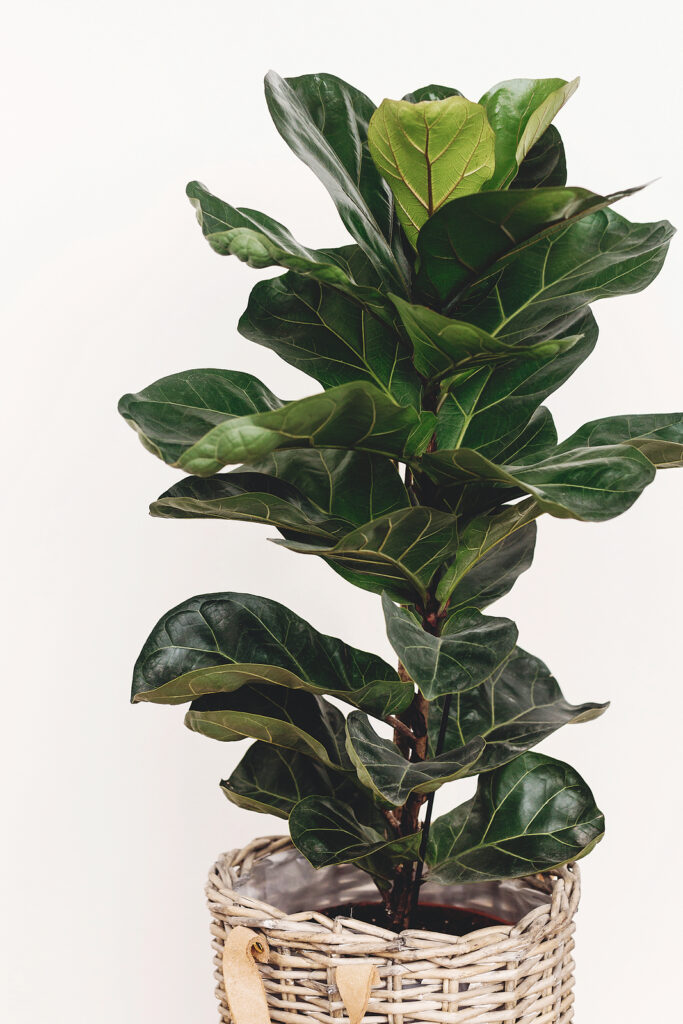Ficus–ornamental figs–can be trees, shrubs, or woody vines. Leaves are commonly thick and resilient and make good houseplants. In warm-winter regions, ornamental figs can be planted outdoors in containers and the landscape.
Ficus is a genus of more than 800 species of trees and shrubs. The Ficus genus includes large trees to 40 feet tall or more and many smaller trees, shrubs, and vines well-suited for indoor growing. Some have woody stems, others are ground-hugging vines. Leaves are green and can be oval, rounded, heart-shaped, or fiddle-shaped from 1 inch to 15 or more inches long.
In warm-winter regions, Ficus can be grown as specimens or shade trees; climbers can be trained against a wall or tree. In all regions, Ficus can be grown as houseplants. Most need direct light, medium humidity, and average to warm temperature indoors.
Ficus tend to drop leaves when they are moved or transplanted. They should be repotted only when their roots appear through the surface of the soil or when they become top-heavy.

Get to know Indoor Ficus
- Plant type: Tropical broadleaf evergreen shrubs and leaves
- Growing Zones and range: Zones 10-15
- Hardiness: Grow outdoors in southern Florida, California, and Hawaii
- Optimal growing temperature: day 80° to 85°F (27°-29°C), night 60°F (16°C)
- Light: Medium to high light; avoid moving plants from high to low light
- Height and width: Grow to 6 feet (1.8m) tall or more depending on the variety
- Foliage: Leaves can be small and paper or large and rubbery
- Uses: Houseplants, outdoor landscape or container planting in warm regions
- Common name: Figs—see below
- Botanical name: Ficus spp.—see below
- Family: Moraceae
- Origin: South and Southeast Asia
Where to plant Indoor Ficus
- Figs need medium to high light; avoid moving plants from high to low light.
- Grow figs in all-purpose planting or potting mix; enrich the soil with aged compost.
- Allow the soil of most figs to dry somewhat between waterings. Keep creeping types evenly moist.

How to water and feed Indoor Ficus
- Keep the soil just moist, not wet.
- Keep figs potbound to prevent overwatering; repot only every 3 to 4 years.
- Fertilize figs twice a year with an all-purpose fertilizer.
Indoor Ficus care
- Wipe large-leaved types periodically with a damp sponge.
- Fresh air is very beneficial to figs.
- Ficus tend to drop leaves when they are moved or transplanted.
- They should be repotted only when their roots appear through the surface of the soil or when they become top-heavy.

Indoor Ficus common problems
- Spider mites and scale can attack if the air is hot and dry; control these by raising humidity and decreasing temperature.
- Treat scale by spraying with insecticidal soap or horticultural oil.
- Lower leaves may drop due to temperature or light changes, drafts, or too little or too much water.
- If the bottom of weeping fig becomes too bare, cut it back to 5 inches above the soil and withhold water until new growth begins.
Indoor Ficus propagation
- Air layer the stems of upright types.
- Creeping fig, weeping fig, and Indian laurel can be propagated from stem cuttings.
- Root creeping types from tip cuttings or divide the rooting stems.

Indoor Ficus varieties to grow
- Ficus benghalensis, banyan tree. Dark green, oval leaves up to 8 inches (20cm) long, covered with fine, reddish hairs.
- F. benjamina, weeping Chinese banyan, weeping fig, or java fig. Grows to 6 feet (1.8m) tall indoors, 30 feet outdoors; small, leathery, oval leaves; common indoor plant; easy to grow in low light; produces more leaves with more light. Use outdoors as a espalier or screen or pation tree.
- F. carica, edible fig. Grows to 8 feet or more; edible fruit; drops leaves in winter.
- F. deltoidea, mistletoe fig. Grows 8 to 10 feet high; roundish, flat, green leaves with pointed tips. Grow in containers as patio and house plant.
- F. elastica, rubber plant. Grows to 6 feet (1.8m) tall or more (40 feet outdoors in tropics); large, thick, elliptical, dark green leaves with prominent mid-ribs; common houseplant. Cultivars include: ‘Burgundy’ has purplish leaves; ‘Decora’ broader, glossier leaves; ‘Rubra’ leaves are reddish; ‘Variegata’ long, narrow leaves variegated yellow and green.
- F. lyrata, fiddle-leaf fig. Large, violin-shaped leaves’ grows 2 to 4 feet (.6-1.2m) tall; leaves along single stem.
- F. microcarpa, Indian laurel fig (same as F. retusa). Similar to weeping figs but with upright branches.
- F. pumila, creeping fig. Fast-growing, dark, oval-leaves to heart-shaped leave; trails or clings to support with aerial roots; roots are invasive.
- F. repens, same as F. pumila, creeping fig.
- F. religiosa, bo-tree. Distinctive pale green oval leaves with long, slender tips.
- F. retusa, Indian laurel. Shrubby form grows 4 to 6 feet (1.2-1.8m) tall; deep green, shiny foliage.



